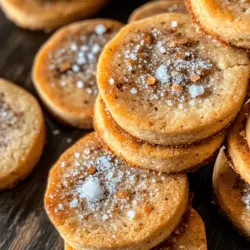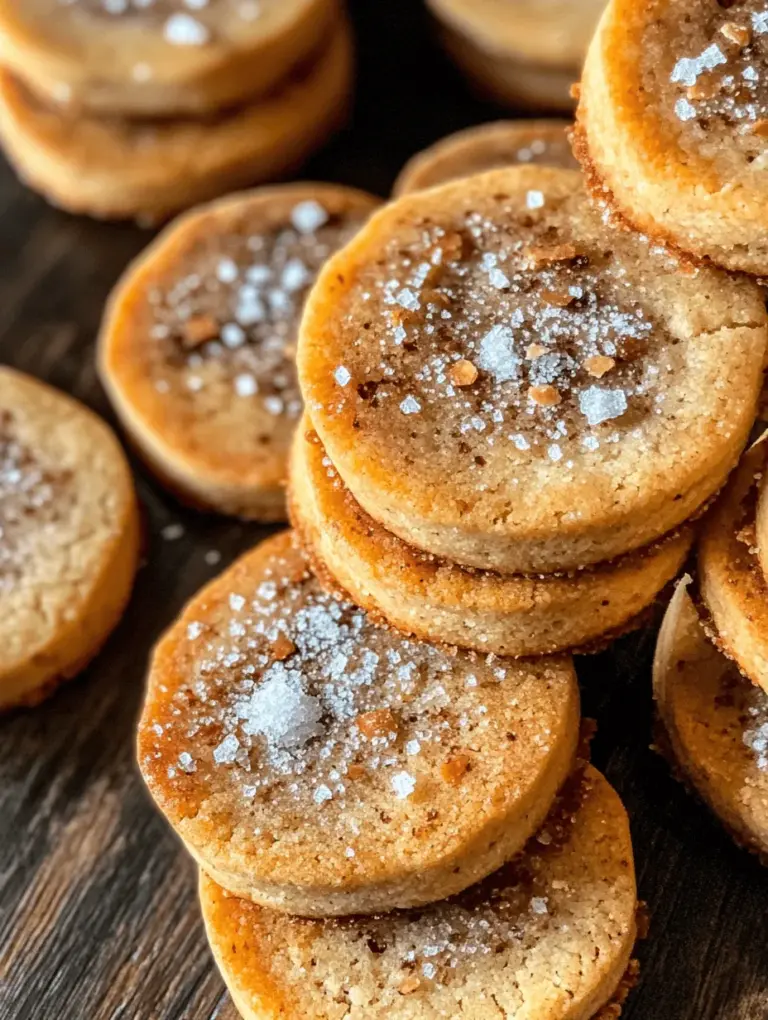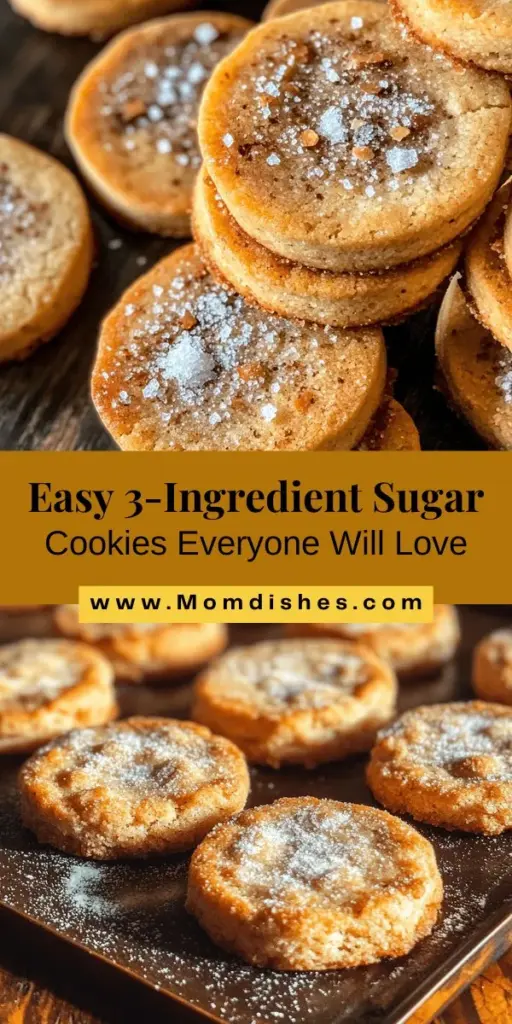Sugar cookies have an undeniable allure that spans generations, captivating taste buds with their sweet, buttery goodness. These delightful treats are not just a favorite among children, but they also hold a special place in the hearts of adults. With their soft texture and sugary crust, they evoke feelings of warmth and nostalgia, often reminding us of family gatherings, holidays, and special occasions. Whether decorated with colorful icing or enjoyed plain, sugar cookies are versatile and beloved by many.
In the world of baking, simplicity is key. With busy lives and endless responsibilities, finding time to bake elaborate desserts can feel overwhelming. This is where the charm of simple recipes shines through. The 3-ingredient sugar cookie recipe is a beacon of simplicity, allowing anyone, regardless of their baking experience, to whip up a batch of delicious cookies with minimal fuss. This recipe not only saves time but also eliminates the need for a long list of ingredients, making it accessible for everyone, including those who may be new to baking.
This article introduces you to an easy and delightful 3-ingredient sugar cookie recipe that requires no special skills or equipment. By using just three ingredients—almond flour, granulated sugar, and coconut oil—you can create cookies that are not only delicious but also cater to dietary preferences. The inclusion of almond flour and coconut oil elevates this recipe, making it a healthier alternative to traditional sugar cookies without compromising on taste.
Understanding the Ingredients
Almond Flour: A Nutritious and Versatile Choice
When it comes to baking, the choice of flour can significantly affect the final product. Almond flour stands out as an exceptional option, particularly for those seeking gluten-free alternatives. Made from finely ground almonds, this flour is rich in nutrients, including vitamin E, magnesium, and healthy fats. These features not only add a nutritional boost to your cookies but also contribute to a moist and tender texture that is often lacking in traditional wheat flour.
Almond flour’s versatility is another reason why it has gained popularity among bakers. It lends a subtly nutty flavor to baked goods, enhancing their taste profile without overpowering the sweetness of the sugar. Additionally, its ability to absorb moisture helps maintain the cookies’ softness, ensuring that each bite is a delightful experience. For those who are gluten-sensitive or following a gluten-free lifestyle, almond flour is an excellent choice that allows you to indulge in classic treats without worry.
Granulated Sugar: The Sweetest Ingredient
Granulated sugar is a staple in baking, serving as the primary source of sweetness in many recipes. In this 3-ingredient sugar cookie recipe, sugar plays a crucial role in not only flavor enhancement but also texture development. It helps create that signature crisp outer layer while keeping the interior soft and chewy—an ideal combination for any sugar cookie.
When comparing granulated sugar to other sweeteners, it’s important to note that each sweetening agent brings its unique characteristics to the table. For example, brown sugar adds moisture and a hint of caramel flavor, while powdered sugar is commonly used for frostings and icings. However, granulated sugar remains the classic choice for sugar cookies, providing a clean, sweet taste that perfectly complements the other ingredients.
Coconut Oil vs. Unsalted Butter: Choosing the Right Fat
The third ingredient in our simple sugar cookie recipe is coconut oil. When it comes to choosing the right fat, bakers often debate the merits of coconut oil versus unsalted butter. Both options have their advantages, but coconut oil brings unique health benefits that make it an appealing choice for this recipe.
Coconut oil is known for its high saturated fat content, which may seem counterintuitive to health-conscious individuals. However, these saturated fats are mostly medium-chain triglycerides (MCTs), which are metabolized differently than other fats. MCTs can provide a quick source of energy and may even aid in weight management. Additionally, coconut oil is lactose-free, making it suitable for those who are dairy-sensitive or vegan.
On the other hand, unsalted butter is a traditional baking fat that imparts a rich, creamy flavor to cookies. It aids in achieving a tender texture and adds moisture to baked goods. While butter has its own merits, using coconut oil in this recipe allows for a dairy-free option without sacrificing taste or texture, making these cookies accessible to a broader audience.
Step-by-Step Guide to Making Simple Sugar Cookies
Prepping Your Kitchen
Before diving into the baking process, it’s essential to prepare your kitchen and gather all necessary tools and ingredients. A well-organized kitchen makes baking more enjoyable and efficient. Start by measuring out your ingredients accurately, as precise measurements are crucial for achieving the best results in baking. This sugar cookie recipe is straightforward, but attention to detail will ensure that your cookies turn out perfectly every time.
You will need a few essential tools to get started:
– Mixing Bowl: A medium-sized bowl for combining your ingredients.
– Baking Sheet: A flat sheet for placing your cookies in the oven.
– Parchment Paper: Optional but recommended for easy cleanup and to prevent sticking.
– Spoon or Spatula: For mixing and portioning the dough.
– Oven Mitts: Safety first—always use mitts when handling hot baking sheets.
Preheating the Oven
One of the most critical steps in baking is preheating your oven. The temperature at which you bake can significantly impact the texture and appearance of your cookies. For this 3-ingredient sugar cookie recipe, preheat your oven to 350°F (175°C). By allowing the oven to reach the desired temperature before baking, you ensure that your cookies cook evenly and develop the perfect golden-brown crust.
To make the most of your oven’s capabilities, keep the following tips in mind:
– Avoid Opening the Oven Door: Each time you open the oven door, heat escapes, resulting in uneven baking. Try to resist the urge to peek until the cookies are nearly done.
– Use the Center Rack: Position your baking sheet on the center rack for even heat distribution. If your oven has hot spots, consider rotating the baking sheet halfway through the baking time for consistent results.
Mixing the Ingredients
With your kitchen prepped and the oven preheating, it’s time to mix your ingredients. Start by combining the almond flour and granulated sugar in your mixing bowl. Use a spoon or spatula to ensure they are thoroughly mixed before adding the coconut oil.
For the coconut oil, it’s best to use it in a softened or melted state for easier incorporation. If your coconut oil is solid, you can gently warm it in the microwave for a few seconds or place it in a warm bowl to soften. Once the coconut oil is ready, pour it into the mixing bowl and combine it with the flour and sugar mixture.
Mix the ingredients until they form a smooth dough. If the dough feels too dry, you can add a teaspoon of water or additional melted coconut oil to achieve the right consistency. Aim for a dough that holds together nicely without being overly sticky.
Forming and Shaping the Cookies
Once your dough is ready, it’s time to form the cookies. Start by portioning the dough into small balls—about 1 tablespoon each. You can use your hands or a cookie scoop for uniformity.
Next, place the dough balls on your prepared baking sheet, ensuring there is enough space between them for spreading during baking. A good rule of thumb is to leave about 2 inches of space between each cookie.
To give your cookies their signature shape, gently flatten each ball with the bottom of a glass or your palm. This step helps create a uniform thickness, ensuring even baking. If you prefer a more decorative touch, you can use a fork to create a crisscross pattern on the tops of the cookies.
Baking the Cookies
With your cookies shaped and ready to go, it’s time to bake them. Carefully place the baking sheet in the preheated oven and set a timer for 10-12 minutes. The exact baking time may vary slightly depending on your oven and the size of your cookies, so keep an eye on them as they bake.
As the cookies bake, look for visual cues to determine their doneness. The edges should be lightly golden, while the centers may appear slightly soft. Remember that cookies continue to bake on the baking sheet even after being removed from the oven, so it’s better to underbake them slightly than to overbake.
Once the cookies are done, remove them from the oven and allow them to cool on the baking sheet for a few minutes. This will help them firm up before transferring them to a wire rack to cool completely. Enjoy the delightful aroma filling your kitchen as your sugar cookies bake to perfection!
{{image_1}}
Understanding the Cooling Process and Its Effects
Once you’ve baked your simple 3-ingredient sugar cookies, the cooling process becomes crucial for achieving the ideal texture and flavor. When cookies come out of the oven, they are hot and soft, making them prone to breaking if you try to move them too soon. Allowing them to cool on the baking sheet for about 5 minutes before transferring them to a wire rack will help them set properly.
Cooling allows the sugars in the cookies to crystallize, which enhances their structure. If you skip this step, your cookies may end up too soft and crumbly. Once they’ve cooled on the rack, they will firm up and develop a delightful chewiness, making them perfect for stacking or packaging.
Flavor Variations and Customizations
One of the best aspects of the simple 3-ingredient sugar cookies is their versatility. You can easily add a variety of flavors or mix-ins to create your own signature cookie.
Adding Flavor Enhancements
Enhancing the flavor of your sugar cookies is simple and can elevate them from basic to extraordinary. Here are some ideas:
– Vanilla Extract: A classic addition, vanilla extract provides a warm, rich flavor that complements the sweetness of the cookies. Start with 1 teaspoon for a subtle enhancement.
– Almond Extract: For a unique twist, substitute almond extract for part of the vanilla. This will give your cookies a delightful nutty flavor. Use it sparingly, as its potency can easily overpower the other flavors.
– Citrus Zest: Adding the zest of a lemon, lime, or orange can infuse your cookies with a refreshing brightness. About 1 teaspoon of zest will do the trick.
Incorporating Mix-ins
Mix-ins can add texture and additional flavor to your sugar cookies. Here are some popular options:
– Chocolate Chips: Stir in ½ to 1 cup of semi-sweet or dark chocolate chips for a classic chocolate chip twist.
– Nuts: Chopped walnuts, pecans, or almonds can add a satisfying crunch. About ½ cup should provide a nice balance without overwhelming the cookie.
– Dried Fruits: Consider adding dried cranberries, raisins, or apricots for a chewy texture and bursts of sweetness.
Creating Frosted Sugar Cookies
Frosting your sugar cookies can transform them into a festive treat perfect for any occasion. Here’s a simple frosting recipe:
– Basic Frosting: Mix 1 cup of powdered sugar with 1-2 tablespoons of milk and a splash of vanilla extract. Adjust the consistency by adding more sugar for thickness or more milk for a thinner glaze.
– Decorating Tips: Use a piping bag for intricate designs or simply spread a layer of frosting with a spatula for a more rustic look. You can also sprinkle colored sugar or edible glitter on top for extra flair.
Serving Suggestions and Pairings
Perfect Pairings
Pair your freshly baked sugar cookies with complementary beverages to enhance the overall experience. Here are some suggestions:
– Milk: A classic pairing, cold milk balances the sweetness of the cookies and is perfect for dunking.
– Coffee: The rich, bold flavors of coffee contrast beautifully with the sweetness of the cookies, making it an excellent afternoon treat.
– Tea: A warm cup of tea, whether black, green, or herbal, can provide a soothing backdrop to your cookies.
Serving Ideas for Different Occasions
These sugar cookies are suitable for various occasions, and how you serve them can elevate the experience:
– Birthday Parties: Decorate your cookies with colorful frosting and sprinkles to match the party theme. Consider using cookie cutters to shape them into fun designs.
– Holidays: Get creative with festive decorations, such as red and green icing for Christmas or pastel colors for Easter.
– Casual Get-Togethers: Serve them on a decorative platter with a selection of beverages for a relaxed afternoon gathering with friends.
Presentation Tips
How you present your cookies can make them even more appealing. Here are some creative ideas:
– Cookie Jars: Fill glass jars with your cookies and tie a ribbon around the lid for a charming gift or centerpiece.
– Tiered Stands: Use a tiered cake stand to display your cookies at parties, adding height and visual interest.
– Baking Paper: Line a basket with colorful baking paper to hold your cookies, making them easy to grab and enjoy.
Health and Dietary Considerations
As with any recipe, it’s essential to consider health and dietary needs, especially when sharing with others.
Nutritional Benefits of the Recipe
This sugar cookie recipe, while indulgent, can be modified to fit various dietary preferences without sacrificing flavor. Here’s how:
– Low-Carb or Keto-Friendly Aspects: By substituting regular flour with almond flour or coconut flour, you can create a cookie that is lower in carbohydrates, appealing to those on a keto diet.
Allergen Considerations
If you’re serving guests with allergies, consider these substitutions:
– Nut-Free Options: Use sunflower seed butter instead of nut butter and ensure your mix-ins are free from cross-contamination.
Vegan Adaptations
To modify the recipe for a vegan diet, simply replace the butter with a plant-based alternative, such as coconut oil or vegan butter. You can also substitute the eggs with flaxseed meal or applesauce, using the following ratios:
– Flax Egg: Mix 1 tablespoon of ground flaxseed with 2.5 tablespoons of water, letting it sit for 5 minutes to thicken.
– Applesauce: Use ¼ cup of unsweetened applesauce as a substitute for each egg.
Storing and Freezing Sugar Cookies
Best Practices for Storing Cookies
Proper storage will ensure your sugar cookies remain fresh and delicious. Here are some tips:
– Recommended Containers: Store cookies in an airtight container at room temperature. Layer parchment paper between the cookies to prevent sticking.
– Conditions: Keep them in a cool, dry place away from direct sunlight. Avoid storing them in the refrigerator, as this can make the cookies stale.
Freezing Cookies for Later Use
Freezing is a great way to extend the shelf life of your cookies. Follow these steps:
1. Cool Completely: Ensure your cookies are entirely cool before freezing to prevent condensation.
2. Individual Wrapping: Wrap each cookie in plastic wrap or foil for protection against freezer burn.
3. Storing in a Freezer Bag: Place the wrapped cookies in a freezer-safe bag or container, labeling it with the date.
Step-by-Step Guide to Freezing and Thawing Cookies
1. Freezing: Lay your wrapped cookies flat in the freezer for up to 3 months.
2. Thawing: When ready to enjoy, remove the desired number of cookies from the freezer and let them sit at room temperature for about 30 minutes before serving.
Conclusion
This simple 3-ingredient sugar cookie recipe is not only incredibly easy to make but also offers endless possibilities for customization and flavor experimentation. From adding extracts and mix-ins to frosting and decorating, you can create cookies that suit any occasion or personal preference.
Baking sugar cookies can be a joyful experience, and sharing them with loved ones is even more rewarding. As you experiment with flavors and presentations, you’ll find new ways to enjoy this classic treat. So, roll up your sleeves, gather your ingredients, and start creating delicious memories with your homemade sugar cookies!


